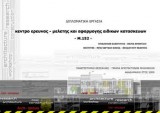Supervisor:
2009
The thesis deals with the construction of a Center for Research, Study and Application of Special Structures in the city of Volos. The research center that we propose is to promote the study of specific structures to facilitate and encourage young researchers to undertake their own ideas about construction and to optimize the relationship between the designer and the production of an object. The way the above objectives are established is through research programs, construction workshops, and finally with exhibitions.
The area chosen is the land across from the Faculty of Engineering, University of Thessaly. The plot is an abandoned industrial building (Building Plataniotis) of 1965 which was previously used as a machine shop. The main reason for selecting the location is the key position of the plot.
The block in which the plot we defined the torrent Krafsidonas and the two main roads entering the city. Thus, access to land is relatively easy by the visitors of the site. The key position of the plot is further emphasized by the fact that it is the meeting point of four areas (Neapolis in the northwest, Nea Ionia in the North, Volos Municipality in the northwest and the region of Palaia in the East).
Through our research into similar research centers some basic and secondary needs areas / functions. So we defined spaces for three units to meet the needs of the Research Center. The Workshop area where you can study, manufacture and assemble a special structure, the offices area where the researchers main offices are with secondary office uses and the Hospitality area with dorms to rest for about 20-25 people.
After the study we did for other research centers we have organized the different research programs which we set at a specific time frame set in conjunction with our building program and scenarios users have helped us to find different ideas. After that we tried to experiment with the relocation of the three different sections in the plot, focusing on access areas and sightings that have been created.
In our final idea initially we tried to put the Workshop area and Offices to interact at various levels. Theoretically, the observation of practice gives the position in the knowledge and continuity in theory and debate and vice-versa. In practice we achieved that by creating a bridge combining the Workshop with the Office area, where the extension of the bridge to the Workshop creates a visual point-to Central Hall (study-assembly-practice), then moving to site Reading area (knowledge) and arrive at the meeting point (theory-discussion-presentation). Similarly, in the ground floor, we have implemented the practice in a direct way in the Central Hall and an imaginary line connection under the bridge (by putting Offices and Workshop entrances opposite each other) the two modules with the theory-presentation-conferences which take place in the Auditorium.
A second element of our final idea is the use of walls as versatile tools. The placement of two walls parallel and along the Workshop area creates a ''possible'' movement between the Workshop and Offices area (side to side movement). On one wall,' 'touching'' the ancillary uses of the unity of Office (Auditorium, colleagues, meeting rooms, printing, etc.) and on the second wall entering the core functions (the offices of the researchers) with a more open and flexible provision in the premises . The corridor created by the two walls is the axle drive unit of the Office area. The third wall (under Hospitality) operates differently. The side facing the small square operates as a limit that leads the visitor to it cuts off while not allowing the visitor to enter the private area (dormitory accommodation). Additional functions as viewing wall and take some interactive uses. The placement of the staircase on the side of the square is to increase the viewing points and motion along the wall. The division of the wall into three parts increases the viewing points. The relationship between spectator and participant changes, relatively to his position, when he walks in the square facing those moving along the wall and so vice versa. Finally, installations in the wall openings can be used for small exhibits and informative posters.
